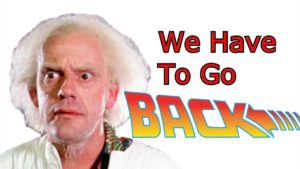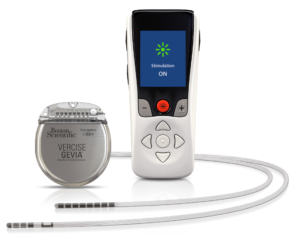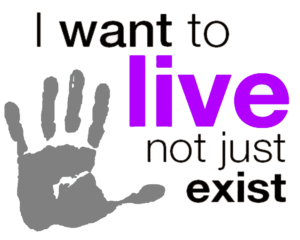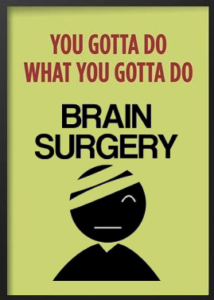 Wow, this is my first blog post after ‘coming back‘ to the blog. And I’m writing it for this year’s Parkinson’s Awareness Month! Feels good to finally get back into blogging and thinking those ‘Deep Brain Thoughts‘… I’ve missed it; but at the same time my life has been a roller coaster going 500 MPH – I guess I’m not only proud to be back but but also humbled.
Wow, this is my first blog post after ‘coming back‘ to the blog. And I’m writing it for this year’s Parkinson’s Awareness Month! Feels good to finally get back into blogging and thinking those ‘Deep Brain Thoughts‘… I’ve missed it; but at the same time my life has been a roller coaster going 500 MPH – I guess I’m not only proud to be back but but also humbled.
And so – here we go! For Parkinson’s Awareness Month 2021 I thought I’d write a bit of ‘My Life‘ – not only what’s been going on with me in my Parkie life (and why I’ve been gone so long and almost gave up the blog in the first place); but also to look to the future with planning a new installment of one of my old blog series. Confused? Well, so am I! Anyway, let’s get started with ‘My Life‘ and you’ll then get the picture (I hope).
 To start, we have to go back in time a bit. So back… back… a little further… “Tom, I see dinosaurs!” No, no, no – you’ve went too far back! Let’s start over, people… Now back… slowly… OK stop right there! It’s early Spring of 2019.
To start, we have to go back in time a bit. So back… back… a little further… “Tom, I see dinosaurs!” No, no, no – you’ve went too far back! Let’s start over, people… Now back… slowly… OK stop right there! It’s early Spring of 2019.
At that time, I noticed that I was beginning to see shorter times ‘on‘ and more times ‘off‘ times during the day. More importantly, it was during these ‘off‘ periods I began to feel something very familiar – something I hadn’t felt in almost 2 years – and that was a small ‘tingling cramp‘ in my left toes. This tightness, as I called it, got worse and worse as the months went on; and by Thanksgiving I was… well, back to having toe cramps and curling in my left foot that was equal to or worse than it was in 2016 before I had deep brain stimulation (DBS)! “But Tom, what happened to your DBS??” Yeah, my DBS…. On my left side I felt it was still giving me some BENEFIT but little to no RELIEF anymore. Why? We still don’t know for certain – but for whatever reason it wasn’t doing it’s job.
During the year, I’d been seeing a number of specialists in regard to this problem – including one of the best DBS programmers in the area – all trying different combinations of settings: Monopolar; Bipolar; Double/Triple Mono/Bipolar; more voltage, less voltage; and everything in between. Yet after numerous programming sessions we found nothing that reduced or eliminated the dystonia – either that program or setting did nothing for the dystonia itself; or it produced wild, uncontrollable side effects, such as large muscle contractions (Luckily, in all this my right foot has remained cramp-free, even to the present time, thank goodness.) Little did I know that Ms. Dystonia, as I call her, was back – and man, was she pissed!!
 Ms. Dystonia Returns!
Ms. Dystonia Returns!
Don’t be fooled by her cute smile , high boots and nice figure – rather, see those horns, the tail, and that 3-pronged pitchfork with which she uses to torture any poor Parkie, like me, whom she sets her eyes upon. As my neurologist said, Ms. Dystonia had returned, WITH A VENGENCE!
By this time, the left toes curling and foot cramping had gotten completely out of control, so much so that we decided to try something radical. We decided to swap out my current Medtronic battery/neurostimulator with a newer, more advanced Boston Scientific battery unit. The Boston Scientific battery, part of their Vercise DBS system, is a smaller, rechargeable, battery that can last 15+ years! For those of us with the older Medtronic hardware, the Vercise unit has two other fantastic features:
- It can work with the old Medtronic leads – meaning you can replace the Medtronic battery with the Boston battery and yet keep your Medtronic leads!
- The Boston unit – based on cochlear implant technology rather than the older pacemaker-based technology used in other systems – is powered by Multiple Independent Current Control Technology (MICC). This allows for refinement of the size and shape of the stimulation field to customize therapy for individual patients. In layman’s terms, it means your doctor can use variable amounts of ‘juice‘ (electricity) on each contact and the areas in-between, allowing more adjustments and therefore better therapy for the patient. For instance you could ‘shape‘ the electrical field between contacts 1 and 2 by specifying 2 amps spread between the contacts (like 75% on contact 1, and 25% on contact 2) This can be very helpful if you have an area around a contact in the brain that is extra sensitive or close to other critical brain areas – in that case, you might want to put a lower amount of juice into that contact.
This is a very basic description of the technology. Click here to see more about Vercise tech, or here to learn about their replacement battery.
 So, in January 2020, I went in for early DBS battery replacement, where my neurosurgeon swapped out my old Medtronic battery and replaced it with a new, shiny, Boston Scientific battery! I have to recharge it once a week; but I can do so in an hour or two while watching TV.
So, in January 2020, I went in for early DBS battery replacement, where my neurosurgeon swapped out my old Medtronic battery and replaced it with a new, shiny, Boston Scientific battery! I have to recharge it once a week; but I can do so in an hour or two while watching TV.
Now although this is ‘very cool‘ tech (and y’all know I’m a techy guy!); we tried everything we could with the new unit – varying the voltage between 2, 3 or even 4 of the contacts; and even more wild settings not possible with the Medtronic – all with the same result: Either none effect at all, or even a worsening effect on the dystonia, (ugh); or it caused, once again, bad side effects such as those severe muscle contractions… some of which were just as nasty as the dystonia!
Throughout the latter part of 2020, we all continued battling COVID, and I continued battling Ms. Dystonia. By the beginning of 2021, she ruled over a large amount of my daily life – I would guess somewhere in the order of 6-8 hours a day. During those hours, my toes would cramp and curl down with such force they would feel, at times, like they were going to dislocate! (That has actually happened, I hear, to others with Ms. Dystonia – she can be heartless!) The pain – was almost unbearable. It also began literally changing my toes from the inside out – twisted downwards, sometimes under other toes, and constant pain… I often said they were beginning to look like they had been run over by a Mac truck! Since the STN DBS wasn’t doing anything for this, we next tried some new drugs – and I mean new, just released stuff. Inbrija, Ongentys, Nourianz… all of which either: Didn’t do next to anything for the dystonia or ‘off‘ times; or they helped a bit but produced bad side effects! I was (and still am) taking Sinemet every 2 hours just to try to keep the cramping toes at bay; then there’s Neupro, COMTAM, Azilect, Amantadine – all of which helped, but since the raising level of Sinemet in my bloodstream caused dopamine levels to rise and fall dramatically in my brain, I was left with massive dyskinesia. But even with all those meds, I still ended up, almost every evening, with the left toes so cramped down I couldn’t separate them, and the foot so tight that it felt like I was walking – if I even could – on gravel! I used to love to read in the evening while relaxing; now it’s “Relaxing?? HA!” I’m usually in so much torture that all I end up most evenings laying down trying to withstand the pain, or sitting in front of the TV trying to figure out how to build some kind of crazy device I could shove in-between or under these accursed toes to keep them from cramping!! I’ve had to completely give up exercising and my Tai Chi (for over a year now); the lack of exercise, along with the constant cramping muscles and then wild dyskinesia, causes me to burn more calories each day than I can take in. So I’ve lost 25-30 pounds during the last year. I can’t travel anywhere – not because of COVID but because I couldn’t WALK wherever I went! But the worst of all was that I was losing my famous optimism; I was simply existing rather than living life. It literally felt like a living nightmare!
 You’ve probably heard someone say something like this, “Nope, no matter what happens, I will NOT ever do this-or-that…. Uh-uh, no way!” A lot of times this is said in response to a thing or process that would, in the end, help the person, but just seems too far out or extreme at the time. Then later on you hear that same person went ahead and done whatever they said previously they would NEVER do!
You’ve probably heard someone say something like this, “Nope, no matter what happens, I will NOT ever do this-or-that…. Uh-uh, no way!” A lot of times this is said in response to a thing or process that would, in the end, help the person, but just seems too far out or extreme at the time. Then later on you hear that same person went ahead and done whatever they said previously they would NEVER do!
I was that way before I had my DBS – saying ‘Nope, not me, no one is boring holes in my head then sticking wires in!“. Yet, after time had passed and the situation got worse and worse, what happened? Yep, I had two holes drilled in my head and two wires put into my brain.
You may now see where I’ve been going all along with this story… By this time time in my story I was extremely depressed, in almost constant pain, and with little hope, since we had tried just about everything for my dystonic left toes/foot, with no success. Well… almost everything. There was one idea left – one method that may have a better chance for success than any other method… Yet this idea had elicited the same response from me as it did the first time – after I was done with my first DBS; I said, “Never again, no need to anyway, but no matter what I’m not going through THAT again!” Well, folks, here I am eating my words again, because it turns out there that the one option left to try is this : I go BACK into DBS surgery one more time to have inserted what they describe as a ‘Rescue Wire‘.
 “WHAT, Tom? You’re going to go through DBS surgery AGAIN?!?” Yep, that is pretty much what’s happening. You see, the last DBS surgery inserted lead wires into my Subthalamic Nucleus, or STN. The STN is the ‘standard‘ area that is used for most Parkinson’s patients given DBS. This time, however, they are only going to insert just one lead wire, called a ‘rescue‘ wire, into the Globus Pallidus Internus, or GPi, area of my brain – and only in the right hemisphere (remember, right side of the brain controls the left side of a persons body).
“WHAT, Tom? You’re going to go through DBS surgery AGAIN?!?” Yep, that is pretty much what’s happening. You see, the last DBS surgery inserted lead wires into my Subthalamic Nucleus, or STN. The STN is the ‘standard‘ area that is used for most Parkinson’s patients given DBS. This time, however, they are only going to insert just one lead wire, called a ‘rescue‘ wire, into the Globus Pallidus Internus, or GPi, area of my brain – and only in the right hemisphere (remember, right side of the brain controls the left side of a persons body).
Why is it called a ‘rescue‘ wire? Because it is designed to ‘rescue‘ a person from the specific problem or symptom they are experiencing. And why the GPi? STN is the current ‘standard‘, and if a person having DBS is suffering from Parkinson’s – especially those with tremor – STN is most often the chosen site. Two important reasons why are:
- You get a immediate response from the patient, even in the OR, when you turn on the the device.
- STN DBS allows greater reduction in medication for patients after surgery.
However, the GPi region has evolved as a potential target for DBS in Parkinson’s disease. In fact, GPi DBS has been shown to be an effective treatment strategy for a variety of symptoms, including bradykinesia, rigidity and tremor control. GPi DBS also has an important, direct anti-dyskinetic effect. In addition, GPi DBS is easier to program in the outpatient setting and will allow for more flexibility in medication adjustments (e.g. levodopa).
But the BIG reason I am getting it is because GPi DBS is the PREFERRED target for disabling dystonia. In fact, for dystonia, DBS of the GPi may be the only effective treatment for debilitating symptoms. And I would definitely call my endless foot/toe cramping as debilitating!
So what’s the biggest disadvantage of GPi DBS? Remember when I said that STN DBS produces an immediate response in a patient when it’s activated? Well, that is not the case with GPi… it can take days, weeks, even up to 6 months before the patient sees improvement! Ugh… but I’ve waited years trying to get rid of Ms. Dystonia… so I guess I can wait a little longer.
 Making this whole thing even more crazier than it already is… well, we decided it was time to downsize. That means — yep, we sold our house and bought a condo! No joke – and we make the move in a little over a month. Exciting? Yes… Does it make me feel even more crazy? The picture that I grabbed for this section says it all…. a blubbering crazy man!
Making this whole thing even more crazier than it already is… well, we decided it was time to downsize. That means — yep, we sold our house and bought a condo! No joke – and we make the move in a little over a month. Exciting? Yes… Does it make me feel even more crazy? The picture that I grabbed for this section says it all…. a blubbering crazy man!
Finally… “Wait, Tom, there’s still MORE?!?” Yep, the final tidbit of info – I wanted to get this post out much earlier, but because of all this craziness, I wasn’t able to till today. And TOMORROW April 26 is my surgery date! At least the first one – the lead wire placement. Talk about waiting till the last second…
 Soooo…. That’s the scoop folks. My first blog post after my delay and what is it? A biggie – but I guess that’s the way I am, big news Tom!
Soooo…. That’s the scoop folks. My first blog post after my delay and what is it? A biggie – but I guess that’s the way I am, big news Tom!
I know this post hasn’t given you guys a lot of info on GPi and such, so I will be continuing my original series, DBS: My Journey to an Electric Brain, with a new installment detailing this latest twist. I’ll detail some more info on GPi, and my journey through this latest surgery. And I’ll try to do it without waiting so long between posts – but with the whirlwind of what is my life recently… well, I promise to try! But rest assured that once I am out of surgery and able to think clearly (maybe a day or two after that) I’ll put out an announcement on the blog telling everyone how I’m doing. And both I and my wife would appreciate any prayers for a safe procedure on Monday.
With that, I leave you with my final thought before surgery tomorrow: Sometimes things get so bad that the unthinkable becomes thinkable – and you gotta do what you gotta do; so brain surgery, here I come again!!
UPDATE: Click here to see the announcement regarding the successful surgery outcome!!
![]()




Please let me know how it went. Praying for you.❤️
Thank you for the prayers, cuz!
Hi Tom, I pray you find resolution to your difficulties. I also thank you for re-establishing your blog. You are an inspiration.
Jerry Howell
Thank you so much for the kind words and prayers, Jerry.
Boy, talk about a long and winding road! I certainly hope this surgery delivers the much needed relief you need and deserve. Keeping both you and Karen in our prayers.
– Cindy and Steve
Thank you, Cindy,for your thoughts and prayers. I just hope this is the last time I have to do this, hopefully this time it will bring some lasting relief!
-Tom
Boy, talk about a long and winding road! I certainly hope this surgery delivers the much needed relief you need and deserve. Keeping both you and Karen in our prayers.
– Cindy and Steve
You are amazing, Tom. Considering the unbelievable (and extremely painful) year you’ve had, here you are writing about your experience in hopes of helping others. You never give up, and that’s what makes you a Hero in my book! Lots of prayers for a safe surgery tomorrow and that you see improvements sooner rather than later. Please give Karen a big hug from me and tell her she has won the Caregiver of the Year Award. She has been on this PD journey with you through thick and thin. You are both very special to me and the entire staff at Michigan Parkinson Foundation. If you need ANYTHING, please call.
Thank you so much, Diane,for those kind words and thoughts. I am so blessed to have your friendship and that of the MPF. I’ve always felt I was given this disease for a reason and that being to help others along way. It’s the only way to maintain sanity with PD… but even more is the fact that it feels rewarding to do so.
So again, thanks Diane, and l’ll let you know if we need anything after surgery. -Tom
Thank you so much, Nancy, for the kind words and thoughts! -Tom
Crossing our fingers for you, Tom. You are courageous and determined and if anyone can succeed at this, it’s you.